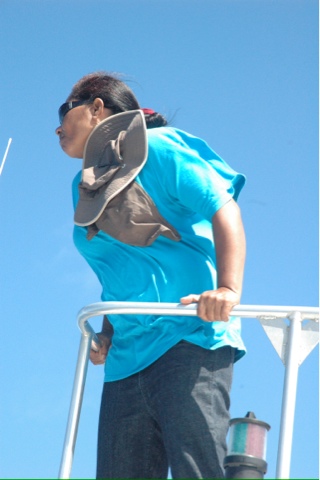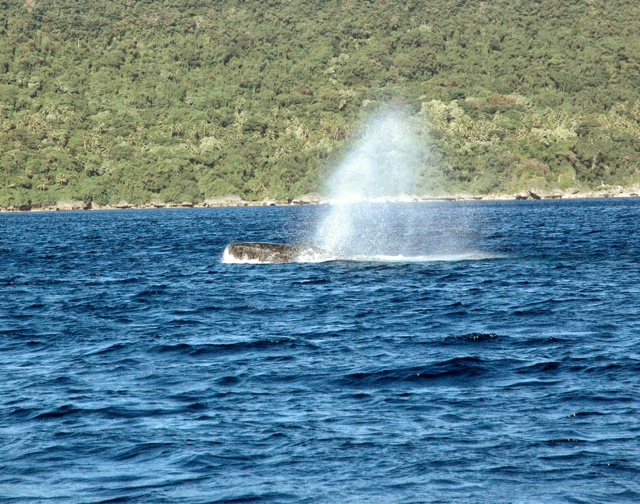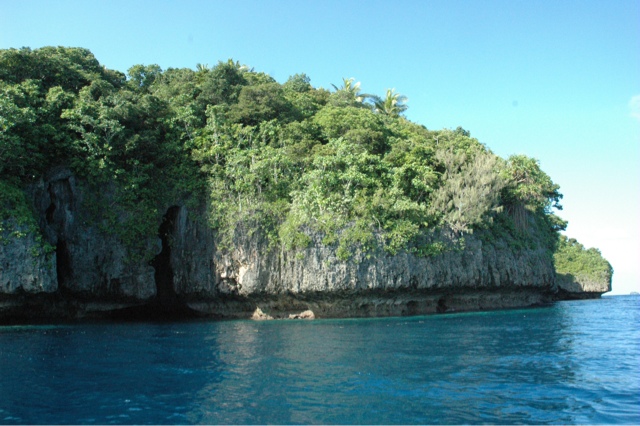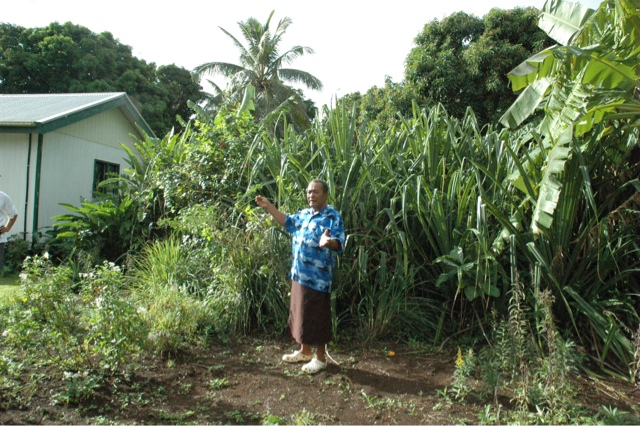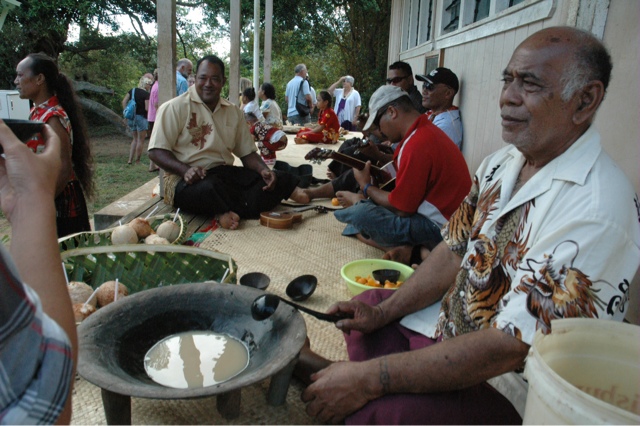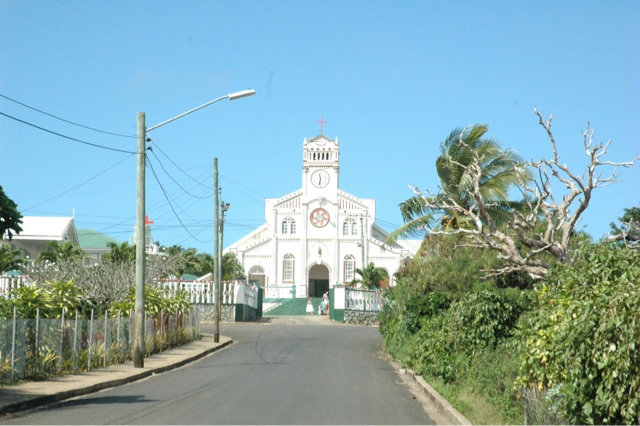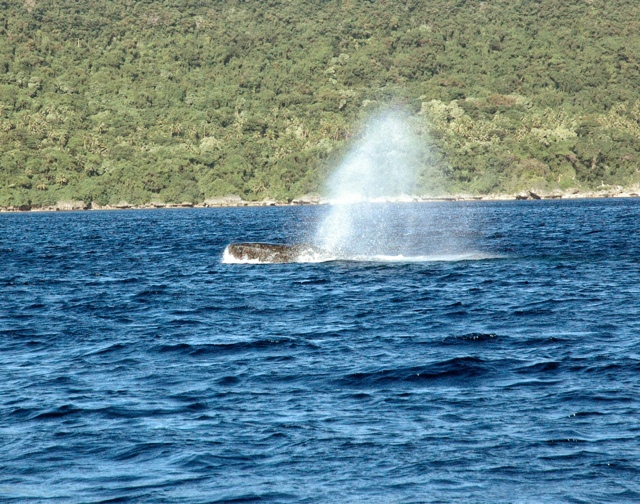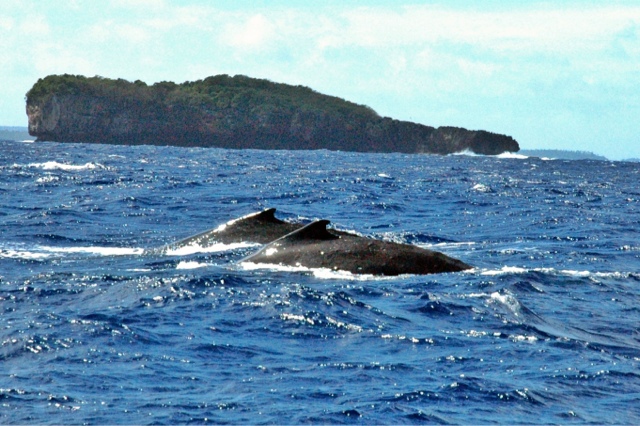We set sail for Fiji with the waxing gibbous moon helping to guide the way. We left Tonga not knowing what treasures await us in Fiji. We heard from a passing sailor the natives are friendly and the food plentiful although we were warned to stay clear of the outlying islands where cannibalism is practiced. The first night's cloud cover made navigation difficult, but the trades were steady from the South East and we had little correction to make at noon on the second day.
Ha! As if the life of a modern day cruiser is like that. We have so much information about the places we are going to already at our fingertips. Our GPS applications keep us on track during the journey regardless of the weather and we can calculate our arrival time almost to the minute. We make our decisions on where to moor by whether or not there is easy access to good food stores and the quality of the wifi in that location. And, not surprisingly, the locals in the towns and cities are not much different than in many other places in the world. It is incredible to see the same name brand products; shoes, shirts, sunglasses, as you would in any North American or European city. We are truly a global community.
Having said that, there is still a great deal of charm and uniqueness in these small islands in the South Pacific. You don't need to move too far out from the town to see the more traditional way of life and feeling of community that is inherent in these cultures. I have to wonder though, how many more generations it will be before all of this completely disappears.
We arrived to Savusavu, Fiji in the middle of the night. We picked up a mooring ball, went to bed for a few hours and are now waiting for the clearing in process before we can get to shore.
Friday, August 16, 2013
Sunday, August 11, 2013
An Update on The Journey
As we sail our way across the Pacific, we occasionally make small changes to our plans, deciding which countries and islands to visit as we go along. Lucky for us, we don't have to seek approval for these changes. We check the wind, the calendar, confer with each other and then go for it. But it also means I often forget to tell everyone what we have decided. I was looking at our blog the other day and realized that we still had New Zealand as our destination for this season.
To update everyone, some time back we decided to sail directly to Australia instead of stopping in New Zealand. A couple of things drove this decision. Firstly, the passage to New Zealand is typically made from the southern Tongan group of islands which means we would miss visiting Fiji and New Caledonia. It can also be a difficult passage to New Zealand as the weather windows between storms is usually shorter than the time it takes to make the passage. So you are either heading out on the tail end of a storm, or arriving at the beginning of some bad weather. Secondly, the Tasman sea, which we would have to cross to reach Australia, is also known to be difficult and it is recommended that you don't leave New Zealand until May. That meant we would have spent 7 months in New Zealand. And lastly, to fly home from New Zealand we would be flying via Sydney anyway. That convinced us to sail SEGWUN to Australia and then fly across to New Zealand and do our touring by car/camper van early next year.
Our new plan has us visiting Fiji and New Caledonia on our way to Brisbane this season. We expect to get to Brisbane by the beginning of November. Then it's time to take a break from the boat, head home to Denmark and then Canada for Christmas and New Year. We'll be back to Australia and New Zealand in January for a few months of land travel before moving on once again.
You can see by the map below how far we have traveled. It has been a fantastic voyage so far. We have visited many places that we never thought we would be so fortunate to get to as well as a few places we didn't even know existed.
To update everyone, some time back we decided to sail directly to Australia instead of stopping in New Zealand. A couple of things drove this decision. Firstly, the passage to New Zealand is typically made from the southern Tongan group of islands which means we would miss visiting Fiji and New Caledonia. It can also be a difficult passage to New Zealand as the weather windows between storms is usually shorter than the time it takes to make the passage. So you are either heading out on the tail end of a storm, or arriving at the beginning of some bad weather. Secondly, the Tasman sea, which we would have to cross to reach Australia, is also known to be difficult and it is recommended that you don't leave New Zealand until May. That meant we would have spent 7 months in New Zealand. And lastly, to fly home from New Zealand we would be flying via Sydney anyway. That convinced us to sail SEGWUN to Australia and then fly across to New Zealand and do our touring by car/camper van early next year.
Our new plan has us visiting Fiji and New Caledonia on our way to Brisbane this season. We expect to get to Brisbane by the beginning of November. Then it's time to take a break from the boat, head home to Denmark and then Canada for Christmas and New Year. We'll be back to Australia and New Zealand in January for a few months of land travel before moving on once again.
You can see by the map below how far we have traveled. It has been a fantastic voyage so far. We have visited many places that we never thought we would be so fortunate to get to as well as a few places we didn't even know existed.
Saturday, August 10, 2013
Tongan Feasts
Let's start with the feast for the eyes. The islands of Tonga are lovely, lush green with large mango trees and coconut palms towering over. There are many small islands, some with beaches and others with steep sides and caves. And the sights under the water are also very pretty. The coral reefs are abundant and varied with many different types of corals rivaling the coral gardens of the Red Sea. It makes for some great snorkeling. Not to mention the Humpback Whales. Oh yes, let me tell you about that.
We went with a company called Beluga Dive which is owned by a Dutchman and his Tongan wife Moa. Moa is the whale spotter and stands atop the boat searching for whales. When she spots the whales, the boat slowly approaches to see if they are ok with us being there. If they're not, they move on, and so do we. The whale watching outfitters are very aware that it is a privilege to see the whales and they work together to make sure the whales are not feeling harassed in any way. They limit the number of people in the water with them at any one time and they keep the boat a respectable distance away. If the whale exhibits behavior indicating anxiety of any kind, the boat moves on. This can mean some customers don't get to be up close and personal with the whales. However, we were lucky and had a really wonderful experience.
After some searching around the islands we found a couple of large adult whales that seemed quite fine with us being there. We would jump in the water in groups of four with our wetsuits and mask and snorkel, the guide leading us closer to the whales to hover over them, watching as they slowly rise from their most recent dive. And as they slowly rise, almost within arms reach, you fully appreciate their enormous size. They would come to the surface, take a few breaths before diving back down. And with a gentle wave of their tail, submerge again. They are fantastic, amazing, magnificent...well you get the idea. Words cannot describe it. What an experience!
A visit to Tonga would not be complete without attending a traditional Tongan feast with roasted pig and a variety of local dishes. We anchored off Lape Island to attend the feast together with many other cruisers. Our host, Kolio, gave us a tour of the island. We saw the plant they use for weaving, learned how to husk a coconut and had a chance to try the local beverage, Kava. Kava is a drink made of local plants, I'm not sure which (Jens says it is made from the root of a pepper plant), but it looks like muddy water. Jens had a taste of it, I passed preferring to stick to the coconut water. We gathered back to the pier for the buffet and after the pastor led the islanders through a song of praise for the food and a prayer, dinner was served. The piggy was yummy and the potatoes and taro were starchy. I know I am a fussy eater sometimes, but I don't think Jens or I would adopt any of their recipes anytime soon, if you know what I mean.
But we also had some other great feasts. We have met up with our new friends Ken and Lil Bardon from S/V Moonbeam. Needless to say Moonbeam is also an Island Packet. She's just a few feet larger than Segwun (10 feet actually) and is on her way to New Zealand. We first met them in Tahiti and have had some fun nights together with them and their ever-changing crew. In Tonga we had a traditional American BBQ with steaks and potatoes aboard Moonbeam with Ken, Lil, Edie, Steve and Jon. And the following morning we had a traditional Canadian pancake breakfast complete with Maple Syrup and Blueberries aboard Segwun.
Let's not forget the feast for the ears. We had already experienced the wonderful singing at the church service. But nothing can beat the bright eyes, beautiful smiles and voices of children singing at school. We visited Matamaka GPS with Ken and his crew. They had already been to the island and this time came with gifts of books and school supplies. The children sang for us and as a way to practice their English they each stood in turn and told us their names and age, what their parents do (mothers are housewives or teachers and fathers are fishermen or pastors) and what they want to do when they grow up. Pitisi, the teacher at the school, is trying to expose the children to other career options so we too had to say what our jobs had been (after telling our names and ages...). After many visiting yachties, the children now have the aspiration to be policemen, engineers, doctors, nurses and pilots. But it will be a long road for these island children. Attending secondary school means leaving your island and family each week. And to attend University means leaving Tonga altogether most going to New Zealand or Australia. Only the smartest are supported with government grants.
With all these Tongan feasts, we are just about ready to move on. Next stop...Fiji!!!
We went with a company called Beluga Dive which is owned by a Dutchman and his Tongan wife Moa. Moa is the whale spotter and stands atop the boat searching for whales. When she spots the whales, the boat slowly approaches to see if they are ok with us being there. If they're not, they move on, and so do we. The whale watching outfitters are very aware that it is a privilege to see the whales and they work together to make sure the whales are not feeling harassed in any way. They limit the number of people in the water with them at any one time and they keep the boat a respectable distance away. If the whale exhibits behavior indicating anxiety of any kind, the boat moves on. This can mean some customers don't get to be up close and personal with the whales. However, we were lucky and had a really wonderful experience.
After some searching around the islands we found a couple of large adult whales that seemed quite fine with us being there. We would jump in the water in groups of four with our wetsuits and mask and snorkel, the guide leading us closer to the whales to hover over them, watching as they slowly rise from their most recent dive. And as they slowly rise, almost within arms reach, you fully appreciate their enormous size. They would come to the surface, take a few breaths before diving back down. And with a gentle wave of their tail, submerge again. They are fantastic, amazing, magnificent...well you get the idea. Words cannot describe it. What an experience!
A visit to Tonga would not be complete without attending a traditional Tongan feast with roasted pig and a variety of local dishes. We anchored off Lape Island to attend the feast together with many other cruisers. Our host, Kolio, gave us a tour of the island. We saw the plant they use for weaving, learned how to husk a coconut and had a chance to try the local beverage, Kava. Kava is a drink made of local plants, I'm not sure which (Jens says it is made from the root of a pepper plant), but it looks like muddy water. Jens had a taste of it, I passed preferring to stick to the coconut water. We gathered back to the pier for the buffet and after the pastor led the islanders through a song of praise for the food and a prayer, dinner was served. The piggy was yummy and the potatoes and taro were starchy. I know I am a fussy eater sometimes, but I don't think Jens or I would adopt any of their recipes anytime soon, if you know what I mean.
But we also had some other great feasts. We have met up with our new friends Ken and Lil Bardon from S/V Moonbeam. Needless to say Moonbeam is also an Island Packet. She's just a few feet larger than Segwun (10 feet actually) and is on her way to New Zealand. We first met them in Tahiti and have had some fun nights together with them and their ever-changing crew. In Tonga we had a traditional American BBQ with steaks and potatoes aboard Moonbeam with Ken, Lil, Edie, Steve and Jon. And the following morning we had a traditional Canadian pancake breakfast complete with Maple Syrup and Blueberries aboard Segwun.
Let's not forget the feast for the ears. We had already experienced the wonderful singing at the church service. But nothing can beat the bright eyes, beautiful smiles and voices of children singing at school. We visited Matamaka GPS with Ken and his crew. They had already been to the island and this time came with gifts of books and school supplies. The children sang for us and as a way to practice their English they each stood in turn and told us their names and age, what their parents do (mothers are housewives or teachers and fathers are fishermen or pastors) and what they want to do when they grow up. Pitisi, the teacher at the school, is trying to expose the children to other career options so we too had to say what our jobs had been (after telling our names and ages...). After many visiting yachties, the children now have the aspiration to be policemen, engineers, doctors, nurses and pilots. But it will be a long road for these island children. Attending secondary school means leaving your island and family each week. And to attend University means leaving Tonga altogether most going to New Zealand or Australia. Only the smartest are supported with government grants.
With all these Tongan feasts, we are just about ready to move on. Next stop...Fiji!!!
Thursday, August 1, 2013
The Sounds of Neiafu
We have been anchored in the bay of Neiafu for a few days now, enjoying the very calm waters and easy access to shore. It is nice to have a break from the constant rocking of the boat. The days here are sunny and warm but the nights cool down beautifully and are usually accompanied by a cool breeze.
The sounds of the sloshing and slapping of the waves against the boat have been replaced by the sounds of a typical town. At dusk, the frogs (I believe they are frogs of some sort) raise their voices. This is followed by the merrymakers at the restaurants on shore. The Aquarium and Mango are just a bit more than a stones throw from our boat so the sound of laughter travels easily to us. Then the village dogs have their chance to settle turf wars or whatever it is they do.
When that is all said and done and you are pretty sure there are still a few good hours left in the night, the roosters start in. All of the islands we have visited since crossing from Ecuador have plenty of free range chickens. And although roosters are supposed to crow at dawn, they start much earlier than the break of day. And I mean much earlier. Somewhere around 3 am is what I'm guessing is when the first one starts. The roosters here cock-a-doodle-doo with gusto, giving it their all.
But for as lovely as all of these sounds are, the best is yet to come. St Joseph's church is nearby on the hill in the bay and the bells start pealing at 6:00 am. The bells are calling the parishioners to mass and when mass begins, so does the singing. By now I am out of bed sitting in the cockpit, watching the sun rise and listening to those heavenly voices singing their praise to God. They sing without the help of an organ, their voices strong and true, singing a Capella.
The Tongans are religious people and after hearing the church bells ringing and the morning singing, we decided to attend church on Sunday. It was a wonderful and moving service even though it was all in Tongan. Everyone was dressed in their finest. The men in Tonga wear long narrow skirts with a knee length woven mat over top. And the women are in dresses with a decorative mat on top. The choir has some truly amazing voices, and when the whole congregation joins in, the church is definitely alive with the sound of music.
The sounds of the sloshing and slapping of the waves against the boat have been replaced by the sounds of a typical town. At dusk, the frogs (I believe they are frogs of some sort) raise their voices. This is followed by the merrymakers at the restaurants on shore. The Aquarium and Mango are just a bit more than a stones throw from our boat so the sound of laughter travels easily to us. Then the village dogs have their chance to settle turf wars or whatever it is they do.
When that is all said and done and you are pretty sure there are still a few good hours left in the night, the roosters start in. All of the islands we have visited since crossing from Ecuador have plenty of free range chickens. And although roosters are supposed to crow at dawn, they start much earlier than the break of day. And I mean much earlier. Somewhere around 3 am is what I'm guessing is when the first one starts. The roosters here cock-a-doodle-doo with gusto, giving it their all.
But for as lovely as all of these sounds are, the best is yet to come. St Joseph's church is nearby on the hill in the bay and the bells start pealing at 6:00 am. The bells are calling the parishioners to mass and when mass begins, so does the singing. By now I am out of bed sitting in the cockpit, watching the sun rise and listening to those heavenly voices singing their praise to God. They sing without the help of an organ, their voices strong and true, singing a Capella.
The Tongans are religious people and after hearing the church bells ringing and the morning singing, we decided to attend church on Sunday. It was a wonderful and moving service even though it was all in Tongan. Everyone was dressed in their finest. The men in Tonga wear long narrow skirts with a knee length woven mat over top. And the women are in dresses with a decorative mat on top. The choir has some truly amazing voices, and when the whole congregation joins in, the church is definitely alive with the sound of music.
Tonga - the Vava'u Group
Tonga is an independent country still operating under a Kingdom although there are some that say they are trying to move to a democracy. The country is made up of 170 islands spread North to South over 500 miles. They are clustered into three groups; Vava'u, Ha'apai and Tongatapu.
We are currently in the Northern group, Vava'u, which is a preferred cruising ground for us yachties who enjoy the many small islands and cozy anchorages. The good folks of Vava'u also provide excellent services for yachties with boat accessible wifi, a morning cruisers information net on the VHF radio, restaurants where they are more than happy to have you come by and chill out for as long as you like, and some social events such as a weekly boat race in the Harbour.
And the big attraction in Tonga (at least for Jens and I) is the Humpback whale which migrate from the frigid waters of the Antarctic to the warmer waters close to the equator every year to breed, give birth and frolic.
As for the journey, we are now officially across the Pacific Ocean although there are about 1900 miles to go to reach Australia. We have a few long passages to make but if the wind is in our favour they should not be longer than 6 days. In the meantime, we will be in Tonga for about three weeks enjoying the beautiful beaches, snorkeling and hopefully lots of whale watching.
We are currently in the Northern group, Vava'u, which is a preferred cruising ground for us yachties who enjoy the many small islands and cozy anchorages. The good folks of Vava'u also provide excellent services for yachties with boat accessible wifi, a morning cruisers information net on the VHF radio, restaurants where they are more than happy to have you come by and chill out for as long as you like, and some social events such as a weekly boat race in the Harbour.
And the big attraction in Tonga (at least for Jens and I) is the Humpback whale which migrate from the frigid waters of the Antarctic to the warmer waters close to the equator every year to breed, give birth and frolic.
As for the journey, we are now officially across the Pacific Ocean although there are about 1900 miles to go to reach Australia. We have a few long passages to make but if the wind is in our favour they should not be longer than 6 days. In the meantime, we will be in Tonga for about three weeks enjoying the beautiful beaches, snorkeling and hopefully lots of whale watching.
Subscribe to:
Posts (Atom)

